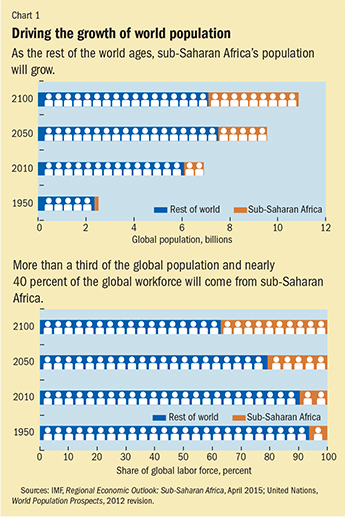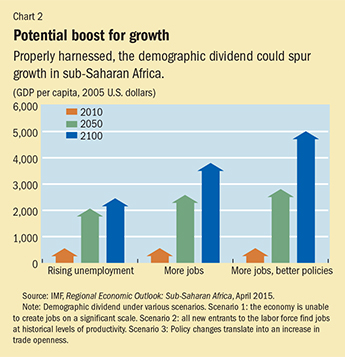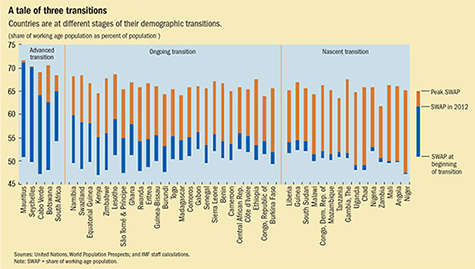Surf the Demographic Wave
Finance & Development, March 2016, Vol. 53, No. 1
Vimal Thakoor and John Wakeman-Linn

Sub-Saharan Africa could reap significant benefits from its growing population—if the transition is well managed
Sub-Saharan Africa’s most formidable economic asset could soon be its people. As the region’s demographics change, it can enjoy significant growth if policies are tailored to tap into this potential.
Declines in infant mortality and longer life expectancy are contributing to an increase both in the overall population and, more important, in the share of the population that is of working age. This changing population structure—referred to as a demographic transition—has historically offered countries an opportunity for higher growth and prosperity. For sub-Saharan Africa, the opportunity is even bigger because the working-age population is rising when much of the rest of the world’s workforce is set to decline.
The transition in numbers
The demographic developments are significant from every angle. Put simply, the region will be the world’s key demographic player this century. While the rest of the world is aging, sub-Saharan Africa will become the main source of growth for the global labor force. The region’s population of slightly more than 800 million in 2010 is projected to more than quadruple by 2100, to 3.7 billion (according to the United Nations’ medium-fertility scenario). Its share of the global population will increase from less than 12 percent to about 35 percent. More striking is the fact that Africa will account for nearly 100 percent of the projected 2 billion increase in the global labor force over that period, raising its share of the global workforce from about 10 percent to 37 percent by 2100 (see Chart 1).

Beyond the simple increase in the number and share of working-age population, the policies accompanying the demographic transition in sub-Saharan Africa can contribute to a dividend. If policies support productive jobs for these new workers, the increase in the workforce will lead to higher growth and rising income per person—voilà: the demographic dividend.
In Africa, the transition could produce a significant dividend through four additional channels (Galor and Weil, 2000; Bloom and others, 2009). First, the decline in fertility rates allows for greater female labor force participation, which increases the employable share of the working-age population. In addition, given that working-age adults tend to save more than other groups, overall saving increases, which allows for more investment financing and gives a further boost to growth. Moreover, evidence suggests that when people have fewer children and live longer, there is an increase in health care and education spending, which contributes to a healthier, more educated, and hence more productive labor force. Finally, an increase in the population could lead to greater domestic demand and spur both local and foreign investment.
Higher growth
Properly harnessed, the demographic dividend for sub-Saharan African countries can be significant. The size of this dividend, and when it materializes, will depend on the ability of economies to absorb the new entrants into the labor force, how supportive policies are in the demographic context, and the success of policies aimed at reducing fertility rates (Drummond,Thakoor, and Yu, 2014).

Assuming a scenario in which not all labor force entrants find a job and the share of employed people remains at 2010 levels sub-Saharan Africa’s per capita GDP in 2050 would more than triple, to nearly $2,000 (in real terms) relative to the median 2010 per capita GDP of $600. This estimate reflects not only the larger workforce, but also a continuation of existing trends and catch-up opportunities unrelated to the demographic transition. If all new entrants were absorbed into the labor market, GDP per capita would increase a further 25 percent by 2050 and 54 percent by 2100 relative to the scenario described above. In a best-case scenario—job creation complemented by better policies and lower fertility—the dividend is estimated at nearly 50 percent by 2050 and 120 percent by 2100. The faster transition increases and speeds up the dividend (see Chart 2).
Global ramifications
Given most other regions’ aging populations, the global economy would benefit from integrating Africa’s growing labor force into global value chains, particularly if sub-Saharan Africa can seize a comparative advantage in labor-intensive production. Higher trade openness would aid job creation and allow the region to benefit from capital and technology transfers. From an economic perspective, migration could benefit both sub-Saharan Africa and the rest of the world. Higher remittances would benefit workers’ home countries while employers elsewhere would profit from the influx of labor as they face stagnant or declining numbers of workers in their own countries. Of course, high levels of migration can also have social and economic effects on both source and destination countries, as Oxford professor Paul Collier spells out in Exodus: How Migration Is Changing Our World. Designing migration policies calls for proper balance of economic, political, and social considerations.
Furthermore, the relocation of low-cost production from China to other regions also creates an opportunity for sub-Saharan African countries. But countries can benefit from this flow of capital only if they improve the ease of doing business and reduce the cost—in particular, by removing infrastructure bottlenecks and providing reliable and cost-efficient electricity, water, roads, and access to global markets.
However, neither the demographic transition nor its dividend is guaranteed. To ensure the transition, some countries will have to reduce their persistently high fertility rates. And to seize the potential dividend governments must implement economic and social policies that enable new workers to find productive jobs. Failure to reduce fertility rates or generate jobs for new workers could result in a rapid increase in unemployment, with potentially severe social and economic consequences. In fact, several countries have struggled with rising unemployment as the transition has progressed, emphasizing the challenge of getting the economic and social policy mix right.
The experiences of east Asia and Latin America suggest that each transition is different. Those two regions started their demographic shift at about the same time in the 1960s. However, east Asian countries captured a much higher demographic dividend thanks to policies better tailored to the transition. For instance, improved access to education and family planning encouraged couples to have fewer children while increased investment in human capital upgraded the skills and productivity of the growing labor force. In addition, greater emphasis on manufacturing spurred increases in average productivity in the economy as a whole, as well as integration into global trade, and fostered foreign investment and technology transfers. Flexible labor market policies enabled efficient reallocation of workers toward labor-intensive and more highly productive manufacturing, which helped with the economic transformation. With more people working, financial development allowed for the channeling of the increased saving to investment. These policies complemented each other, so that the east Asian countries could make the most of their evolving demographics.
In sub-Saharan Africa, the demographic transition is taking place much later than in other regions, largely reflecting the delay in the decline in infant mortality as a result of medical advances.
The region will need to overcome three challenges to benefit from a demographic dividend.
First, persistently high fertility rates in many of the region’s countries could both delay and diminish any potential dividend. In a worst-case scenario, a growing population and rising unemployment could exacerbate social risks and political tensions. This could also affect other economies, both in the region and elsewhere, as the number of people emigrating increases.
Furthermore, rising populations will strain public resources and countries’ ability to cater to their people’s needs. To provide these growing populations with even the current level of services, sub-Saharan African countries must expand their road networks; power, water, and sewer systems; and delivery of health and education services. Moreover, to fully exploit the potential demographic dividend, they will need not only to maintain their current level of services, but also to increase per capita investments in health, education, and infrastructure. In addition, timing is a problem: the education and health services need to be upgraded before these new citizens reach working age, but the money to fund those increases will not come until these citizens start working and paying taxes. Rethinking conventional agricultural practices and urban planning will be necessary as well. Improvements in agriculture will be essential to feed the population and free up the labor force to work in higher-productivity sectors, and urban design must factor in the influx of migrants from rural areas in search of jobs.
Finally, the region must create jobs on an unprecedented scale—averaging 18 million a year between 2010 and 2035. The bulk of sub-Saharan Africans work in the informal sector, which will likely remain the main source of employment in the near term. Evidence suggests that most women in sub-Saharan Africa have no choice but to work in the informal sector, because they must both raise children and earn an income. The lower productivity associated with this sector could result in lower-than-average productivity in sub-Saharan Africa during some of its transition.
A mixed picture
The pace and path of the demographic transition, which will ultimately determine whether a country benefits from a demographic dividend, vary greatly across sub-Saharan Africa (see chart).

A first group of mostly small countries is fairly advanced in the process, aided by fast declines in infant mortality and fertility rates. Two of these—Mauritius and Seychelles—now face the challenges associated with an aging population. For a second group, the transition is ongoing but is not expected to peak before 2050, proceeding much more slowly than the transition in either Latin America or east Asia. Namibia and Swaziland are somewhat more advanced within this group, but the transition is still at an early stage for countries such as Ethiopia and Burkina Faso. Of concern is a third group whose transition has been much slower still, largely reflecting continuing high fertility rates, and indeed has stalled in a few cases. Two of the most populous countries on the continent—Nigeria and the Democratic Republic of the Congo—fall into that category.
On a regional basis, the eastern and western parts of sub-Saharan Africa will both see their population exceeding 1 billion by the end of the century. In the southern region population growth will remain largely flat, reflecting the near completion of the transition in South Africa. Nigeria’s population is projected to increase from an estimated 182 million in 2015 to 752 million by 2100. An additional 11 countries in sub-Saharan Africa will have a population topping 100 million by the end of the century.
What needs to be done?
To improve the prospects of harnessing a dividend, macroeconomic policies need to focus on four main areas.
High-quality jobs to absorb new workforce entrants and increase overall productivity: Given that the lion’s share of these jobs will have to be in the private sector, policies that promote flexible labor markets, facilitate the development of labor-intensive sectors that can compete globally, and liberalize trade are necessary to increase employment opportunities. Removing legal and institutional impediments to female labor force participation can aid this process.
Macroeconomic stability must be maintained while spurring economic transformation and facilitating private sector development, including by protecting investor rights, strengthening the rule of law, and reducing the cost of doing business by addressing the infrastructure gap. These policies will likely require increased spending, while maintaining debt sustainability, which requires more government revenue. Reducing distortionary taxes on capital and income can motivate the private sector to expand and will drive the demand for labor.
Human capital investment, including in health care and education, is critical in the early phases to speed the transition and improve the productivity of the workforce. Moreover, access to health care and education is critical to reduce disparity in opportunity and allow a more equitable distribution of the demographic dividend. Upgraded agricultural policies and urban planning are essential as well.
Financial sector development to effectively channel savings into investment can increase employment and growth. At the same time, planning for the nearly 500 million projected increase in pensioners calls for implementation of viable pension systems.
Many of these policies are interlinked, and exploiting their synergies will be critical to increasing the dividend.
Sub-Saharan Africa is at a crossroads. Successful reduction of mortality and fertility, combined with effective implementation of supporting policies, could earn the region a large demographic dividend and improve the quality of life for all its citizens. As a consequence, the region can emerge as a major player in the global economy and help mitigate some of the impact of aging in the rest of the world. At the same time, a failure to seize the opportunities offered by this new demographic situation would pose significant economic and social risks. ■
Vimal Thakoor is an Economist and John Wakeman-Linn is an Advisor, both in the IMF’s African Department.
This article is based on Chapter 2 of the April 2015 IMF Regional Economic Outlook: Sub-Saharan Africa, “How Can Sub-Saharan Africa Harness the Demographic Dividend?”
References
Bloom, David E., David Canning, Günther Fink, and Jocelyn E. Finlay, 2009, “Fertility, Female Labor Force Participation, and the Demographic Dividend,” Journal of Economic Growth, Vol. 14, No. 2, pp. 79–101.
Collier, Paul, 2013, How Migration Is Changing Our World (Oxford: Oxford University Press).
Drummond, Paulo,Vimal Thakoor, and Shu Yu, 2014, “Africa Rising: Harnessing the Demographic Dividend,” IMF Working Paper 14/143 (Washington: International Monetary Fund).
Galor, Oded, and David N. Weil, 2000, “Population, Technology and Growth: From Malthusian Stagnation to the Demographic Transition and Beyond,” American Economic Review, Vol. 90, No. 4, pp. 806–28.


